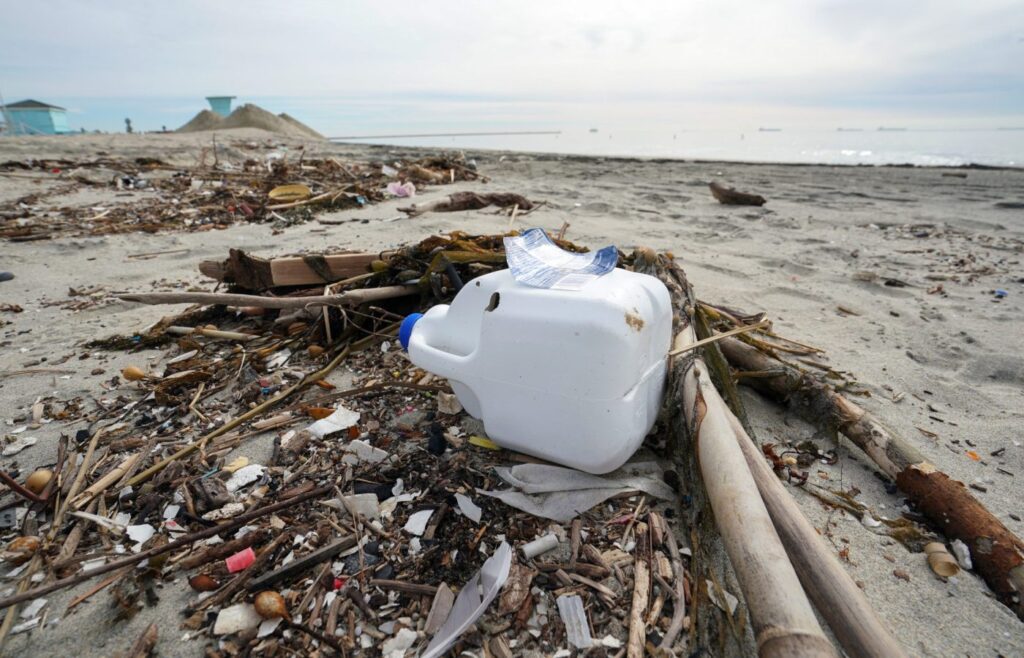
It’s not only visible plastic waste — water bottles and caps, food wrappers, foam packaging — polluting the ocean.
Tiny toxic microplastics less than two-tenths of an inch long can be even more troublesome. They’re virtually impossible to remove once in the water, and they’re readily ingested by marine life. And unless something is done to prevent it, the volume of microplastics in the world’s oceans is projected to increase threefold by 2030, according to the state’s Ocean Protection Council.
In a move to further reduce plastic waste that can break down into microplastics as well as to stem the flow of ocean-bound microplastics, such as laundry microfibers and tire-wear particles, the council unanimously approved an extensive Statewide Microplastics Strategy with 22 recommendations on Wednesday, Feb. 23. The vote was touted as the first microplastics strategy in the nation, and perhaps the world.
Now it’s a matter of turning the recommendations into policy — and action.
“It is a step in the right direction and an indication of how seriously we’re beginning to take this issue,” said Sen. Ben Allen, D-Redondo Beach, who sits on the council. “Microplastics are really becoming a scourge on the ocean.”
Development of the strategy was mandated by 2018 legislation, and the council’s recommendations now go to the Legislature and state agencies to be considered as the basis for new laws and regulations. Those recommendations range from bans on polystyrene foam food containers and cigarette filters to promoting the use of tight-mesh washing machine filters as a way to capture microfibers and other microplastics before they wind up in ocean-bound stormwater and wastewater.
Larger plastics breaking down into microplastics remains a chief concern.
“Plastic waste in the United States is ubiquitous and increasing, with the United States having generated more plastic waste as of 2016 than any other country, exceeding that of all the European Union member states combined,” says the strategy document, citing a National Academies of Sciences, Engineering and Medicine report to Congress in December.
“Worldwide, an estimated 11 million metric tons of plastic enter the ocean each year, with this amount to triple by 2040 if no intervention takes place,” the 34-page document says.
Microplastics, meanwhile, are increasingly found in a broad range of marine life, and have been found to cause tissue inflammation, impaired growth, developmental anomalies and reproductive difficulties, it says.
But microplastics aren’t simply a marine pollution problem.
“Microplastics have been found nearly everywhere scientists have investigated, from pristine mountain streams to agricultural soil, and within human placenta, stool samples and lung tissues,” the document reports.
While some environmentalists would like to see recommendations that go even farther than the council’s strategy, the document was praised by several environmentalists who addressed the council Wednesday.
“Microplastics are an extremely complex issue,” said Emily Parker, a marine scientists with Heal the Bay. “The microplastics strategy will allow much needed guidance.”
New laws
The state has been chipping away at plastic pollution for years, including a landmark 2014 legislative ban on single-use carryout plastic bags that was later ratified by voters, a 2018 law that restricts single-use plastic straws, and a 2021 expansion of the straw restrictions to include plastic utensils and condiment packages.
And this is hardly the Ocean Protection Council’s first trip to the sea-waste rodeo. The council helped to develop the state’s Ocean Litter Prevention Strategy, and last year it approved “Top 10 Recommendations to Address Plastic Pollution in California’s Coastal and Marine Ecosystems.”
The Statewide Microplastics Strategy builds on those documents and, in some cases, reinforces activist and lawmaker calls for new anti-pollution measures.
For instance, a bill that would require all single-use packaging and foodware to be compostable or recyclable has remained stalled in Sacramento for the past three years, and now a measure with the same requirements has qualified for the November ballot. A bill banning single-use cigarette filters and single-use e-cigarettes was introduced in January, as was a bill that would require microfiber filters on all new washing machines.
All three of those correlate with the nine “Pollution Prevention” recommendations in the strategy, which also includes a ban on polystyrene food packaging, expanding a microbead ban to cosmetics and cleaning products, and developing non-plastic alternatives to other products and packaging.
The strategy’s eight “Pathway Interventions” recommendations include a call for retention basins to allow stormwater to settle into the earth rather than flow into the ocean and for more thorough treatment of sewage before it is pumped into the ocean.
Related links
Your recyclables are going to the dump and here’s why
New law aims at keeping food out of the trash
Good news, bad news about your trash
Grocery store efforts on plastic reduction too slow, Greenpeace says
Mountain lions, plastic and climate top environmentalists’ 2022 wish list
The document also identifies tire wear particles as an ocean microplastic, citing a study that estimates 34% of such particles worldwide are transported through the air and into the ocean, and another study that found tire wear particles were “a significant source of microplastics in urban stormwater in San Francisco Bay.”
But an immediate solution to those particles getting into the ocean sounds unlikely, as the closest thing to direct action are the recommendations to reduce stormwater runoff and to encourage the development of alternative materials.
The strategy also includes 12 research priorities, which involve monitoring to better assess the sources and composition of microplastics, assessments to determine specific risk thresholds for humans and marine life, and better inventories of the paths that microplastics take to the ocean.
